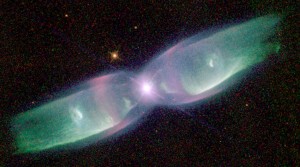Scientists replicate the physics of a stellar jet in laboratory

Astronomers will tell you that among the most beautiful structures observed in the Universe are the intricate jets of matter speeding away from accreting stars, such as young proto-stars and stellar mass black holes. But they have a hard time explaining it. A pair of professors the University of Rochester is hoping to change that.
Earlier this year, Adam Frank, professor of physics and astronomy and his colleague, Eric Blackman, professor of physics and astronomy, were part of what he called "one of the greatest astrophysical experiments that's ever been done." In partnership with a team at Imperial College London led by Professor Sergey Lebedev, they replicated the physics of a stellar jet in a laboratory and matched the known physics of jets "amazingly well." (See video here).
The team demonstrated how "knots" form in stellar jets. According to Frank, though jets are believed to emanate from a star as a steady stream of matter, they quickly become knotted and twisted, creating the astonishing shapes they are known for. The small scale version of the jets recreated in the laboratory shed light on what caused them putting to rest debate among Astrophysicists.
Here's what the team of experimenters did specifically (source):
At Imperial College, Lebedev sent a high-powered pulse of energy into an aluminum disk. In just a few billions of a second, the aluminum began to evaporate, creating a cloud of plasma very similar to the plasma cloud surrounding a young star, says Frank. Where the energy flowed into the center of the disk, the aluminum evaporated completely, creating a hole through which a magnetic field, generated in the process, could penetrate. The field initially pushed aside the plasma, forming a "bubble with a jet inside," says Frank, who carried out the astrophysical analysis of the experiment. As the field penetrated further and the bubble/jet system grew, the magnetic fields began to warp and twist. Almost immediately, a new magnetic bubble formed beneath the first bubble, and the process repeated itself, creating a series of broken bubbles in the plasma.The resulting cloud of plasma, pinched in by the magnetic fields, so closely resembled what astrophysicists observe in real stellar jets that Frank believes the same physics underlies both.
Impressed with the results, the U.S. Department of Energy has now awarded Frank and his team $2.8 million to take the experiment to the next level. Next they will work with researchers from Rice University and the University of California at San Diego, to re-conduct the initial experiment and carry out new ones on Sandia National Laboratories' Z-Machine—an X-ray generator 10 times more powerful than the site of initial experiment, Imperial College's MAGPIE pulsed power facility.
The new grant will allow Frank and the team to replicate jets even more accurately, as well as to get new astronomical observations to nail down exactly how stellar jets evolve in nature.
"It's a whole new way of doing astrophysics," says Frank, who specializes in using supercomputers to simulate astrophysical phenomena. The DOE grant allows us to deepen and extend an unusual international collaboration of plasma physicists, astronomers, and computational scientists."
"We can see these beautiful jets in space, but we have no way to see what the magnetic fields look like," says Frank. "I can't go out and stick probes in a star, but here we can get some idea."
